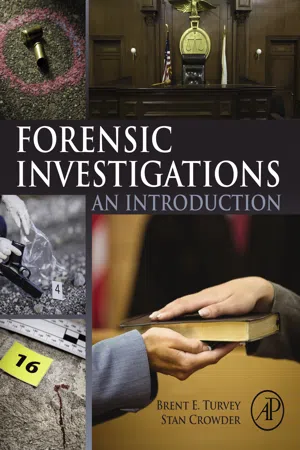
- 414 pages
- English
- ePUB (mobile friendly)
- Available on iOS & Android
About this book
The terms forensic investigator and forensic investigation are part of our cultural identity. They can be found in the news, on television, and in film. They are invoked, generally, to imply that highly trained personnel will be collecting some form of physical evidence with eventual scientific results that cannot be questioned or bargained with. In other words, they are invoked to imply the reliability, certainty, and authority of a scientific inquiry.Using cases from the authors' extensive files, Forensic Investigations: An Introduction provides an overview of major subjects related to forensic inquiry and evidence examination. It will prepare Criminal Justice and Criminology students in forensic programs for more specialized courses and provide a valuable resource to newly employed forensic practitioners. Written by practicing and testifying forensic professionals from law enforcement, academia, mental health and the forensic sciences, this work offers a balanced scientific approach, based on the established literature, for broad appeal.The purpose of this book is to help students and professionals rid themselves of the myths and misconceptions they have accumulated regarding forensic investigators and the subsequent forensic investigations they help to conduct. It will help the reader understand the role of the forensic investigator; the nature and variety of forensic investigations that take place in the justice system; and the mechanisms by which such investigations become worthy as evidence in court. Its goals are no loftier than that. However, they could not be more necessary to our understanding of what justice is, how it is most reliably achieved, and how it can be corrupted by those who are burdened with apathy and alternative motives.- A primary text for instructors teaching forensic courses related to criminal and forensic investigation- Written by forensic professionals, currently in practice and testifying in court- Offers applied protocols for a broad range of forensic investigations- Augments theoretical constructs with recent, and relevant case studies and forensic reports- Based on the most recent scientific research, practice, and protocols related to forensic inquiry
Frequently asked questions
- Essential is ideal for learners and professionals who enjoy exploring a wide range of subjects. Access the Essential Library with 800,000+ trusted titles and best-sellers across business, personal growth, and the humanities. Includes unlimited reading time and Standard Read Aloud voice.
- Complete: Perfect for advanced learners and researchers needing full, unrestricted access. Unlock 1.4M+ books across hundreds of subjects, including academic and specialized titles. The Complete Plan also includes advanced features like Premium Read Aloud and Research Assistant.
Please note we cannot support devices running on iOS 13 and Android 7 or earlier. Learn more about using the app.
Information
Forensic Investigations
A Primer
Abstract
Keywords
Corpus Delicti
Table of contents
- Cover image
- Title page
- Table of Contents
- Copyright
- List of Contributors
- Preface
- Chapter 1. Forensic Investigations: A Primer
- Chapter 2. Law and Evidence
- Chapter 3. Investigative Ethics
- Chapter 4. Investigators and the Scientific Method
- Chapter 5. Crime Scene Investigation and Analysis
- Chapter 6. Crime Scene Processing
- Chapter 7. Forensic Victimology
- Chapter 8. The Sexual Assault Examination
- Chapter 9. Medicolegal Death Investigation: Protocols and Practice
- Chapter 10. Forensic Interviews
- Chapter 11. The Polygraph: Uses and Misuses
- Chapter 12. Investigating Allegations of Police Torture: Forensic Protocols and Psychological Assessment
- Chapter 13. Forensic Investigations for Court: Probation, Sentencing, Mitigation Issues in Capital Cases
- Chapter 14. Oklahoma v. Elvis Thacker: Evaluating Victimology, Victim Sexual Assault Evidence, Suspect Torture by Law Enforcement, and the Quality of a Forensic Investigation
- Index